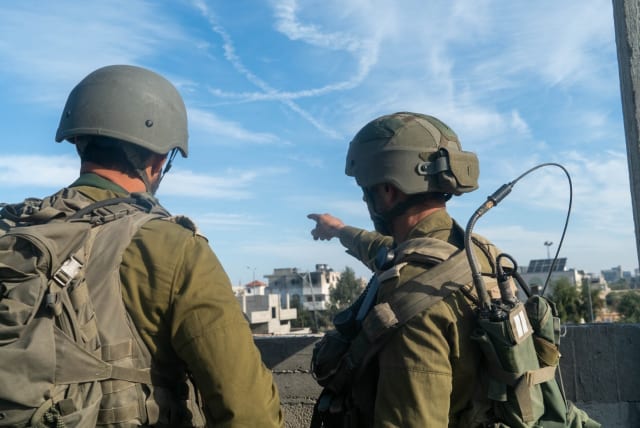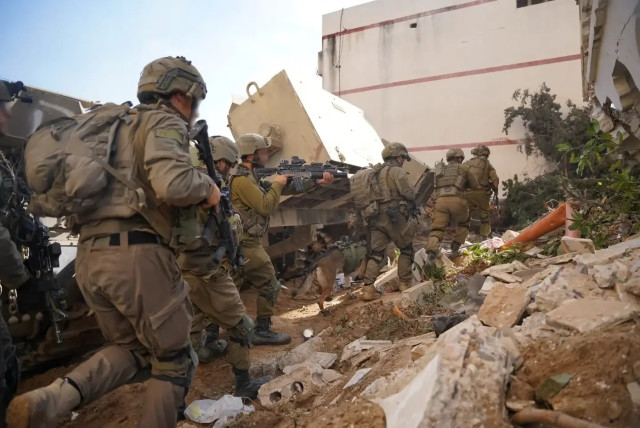Mental resilience: IDF Lt.-Col. shares how to prepare for the worst

Bahat and a colleague have developed a system called Extreme Simulations (EXS).
How to prepare for the worst is a theme of Jonathan Bahat’s life. You might not guess this by reviewing his military CV, which includes events for which preparation seems impossible.
The 48-year-old lieutenant colonel in the reserves and deputy brigade commander in the IDF’s 646 Paratroopers Brigade has served with distinction in the General Staff Reconnaissance Unit (Sayeret Matkal) and the Duvduvan Commando Unit (as in the TV show Fauda), and has taught at the military training school.
Bahat served in Gaza two decades ago and was grazed by a bullet that hit his ceramic vest. He’s also served in Lebanon and Jenin, and completed missions in Angola, Paraguay, and Washington. In his spare time, he trains for triathlons – running, biking, and swimming.
Despite what we can all understand is prodigious physical agility, what has most interested Bahat, even more than physical prowess, is an amorphous quality he calls “mental resilience.” He has a master’s degree in organizational psychology and served in the IDF as a psychological counselor.
What Bahat has discovered is that the most valuable training addresses what you do when everything goes wrong – and he’s seen his share of wrong – for which people need a different kind of resilience preparation. The second time you face a battlefield or life challenge is much easier than the first time, he says. His goal is to practice horrific encounters so that when they actually occur, the genuine first encounter will feel like one that the person has already experienced.
Sounds impossible, right?
But Bahat and a colleague have developed a system called Extreme Simulations (EXS). While many simulations focus on hi-tech, he manufactures low-tech but realistic dummies, replicating the body fluids, skin feel, stenches, and gore of battle. The smells, smokes, and sounds of battle are simulated in realistic scenarios set in Israel and abroad. In the EXS online shop, you can purchase models of third-degree burns like those experienced by tank loaders; limbs amputated by RPGs; and head wounds from bullets and blasts.
The idea, says Bahat, whom everyone calls “Yonti,” is that your physical and emotional experience is burned into your consciousness at one of these extreme practice sessions. They recreate mass casualties and prepare military and police personnel for single shooters, stabbing, disaster sites, and non-conventional weapon attacks.
The importance of preparedness
THIS SYSTEM would be interesting enough if I were hearing about it in a defense exhibition or trade show, but I am sitting in Bahat’s hospital room in the Gandel Rehabilitation Center at Hadassah’s Mount Scopus campus. Bahat is about to leave the hospital for his home and family in Ness Harim, switching to outpatient rehab after six months in Hadassah Ein Kerem and then at Mount Scopus.
Bahat was in Armenia with his wife and their children on Oct. 7. He left immediately, hiring a taxi to take him to Georgia, where planes were leaving for Israel. All seats were taken, but Yonti convinced the pilots to let him fly home – in the cockpit!
He joined his paratrooper brigade, leading the fighting for 100 days against the terrorists while exposing the extensive tunnel network beneath Khan Yunis. Then, in a battle in Zeitoun while he was leading from the front, a terrorist crawled out of a tunnel shaft and shot him at close range with a Kalashnikov.
Bahat took six bullets in his chest, shoulder, arms, and legs. His lung was punctured. He was coughing up blood.
“In the first seconds, I thought I was dying and made peace with it,” he says. “‘What a shame,’ I thought, ‘that my sons will grow up without their dad.’”
The commander somehow managed to walk away from the scene. He insisted that he needed an experienced medic who could immediately do a chest drain on him.
Fortunately, his team had undergone Bahat’s obsessive preparation course. He had determined the landing place of an evacuation helicopter himself, “just in case something dire happened.” He’d also made sure that he wasn’t the only officer who knew the helicopter’s planned landing place, reviewing the location daily.
The senior medic, Litav Esh, was not only experienced but had undergone training with Bahat.
“He was covered with blood, and I didn’t recognize him at first,” Esh said. “When I got to him – barely breathing, bleeding from many places, with his team trying to stop the bleeding and keep him alive – at that moment, I had to decide whether to stay in the field and to treat him on the way, which is more complex due to the rough conditions. I decided that we had to get him on a helicopter quickly.” Still under fire, she agreed to do the chest drain, but warned him that she wouldn’t be using anesthesia because she wanted to keep him awake. Litav was still holding the tube inside his chest as helicopter landed.
THE MILITARY helicopter flight to Barzilai Hospital in Ashkelon took 28 minutes. During the flight, the 669 Airborne Search and Rescue team provided lifesaving medical treatment. At Barzilai, Bahat underwent surgery and was placed in intensive care. He was then transferred to the ICU at Hadassah Ein Kerem.
When we woke up 10 days later, he couldn’t yet speak but made motions that he wanted to write. He asked by name about a soldier who had been wounded with him and about his children, Matan and Rotem. He wanted to let his wife and the staff know that he had his mental faculties.
“Even when you’re training, you never really believe that the worst is going to happen to you,” he says. “Training the technical aspects of war is essential, but it’s not enough. You have to be able to go automatic pilot mentally and emotionally, too.” Shortly before the war, he was in the US practicing with air force cadets for an imaginary terrorist invasion.
Bahat couldn’t walk when he started rehab. Today he runs on the anti-gravity machine, swims against the current in the hydrotherapy pool, and bikes on the stationary physiotherapy machines. A sort of rehab triathlon. And he’s determined to go back to lead his soldiers.
He is one of five brothers, all of whom recently served in the IDF. His brother Nadav, a combat officer who serves under him, assisted in the evacuation, and then hurried back to the battlefield.
Where does this fighting spirit come from? He was born daring, writes older brother Amnon, who had to watch his then-baby brother carefully in his crib.
Bahat’s grandparents were pioneers who left wealthy homes in Poland to settle pre-state Israel in the 1920s. Interestingly, his grandfather worked in Gaza as a supply clerk for the British forces in Egypt. Most of the relatives who remained in Poland were murdered in the Holocaust.
His father is Prof. Dan Bahat, an archaeologist specializing in Jerusalem history. Among other projects, he explicated our city’s ancient tunnels.
The writer is the Israel director of public relations at Hadassah, the Women’s Zionist Organization of America. Her latest book is A Daughter of Many Mothers.
Jerusalem Post Store
`; document.getElementById("linkPremium").innerHTML = cont; var divWithLink = document.getElementById("premium-link"); if (divWithLink !== null && divWithLink !== 'undefined') { divWithLink.style.border = "solid 1px #cb0f3e"; divWithLink.style.textAlign = "center"; divWithLink.style.marginBottom = "15px"; divWithLink.style.marginTop = "15px"; divWithLink.style.width = "100%"; divWithLink.style.backgroundColor = "#122952"; divWithLink.style.color = "#ffffff"; divWithLink.style.lineHeight = "1.5"; } } (function (v, i) { });

